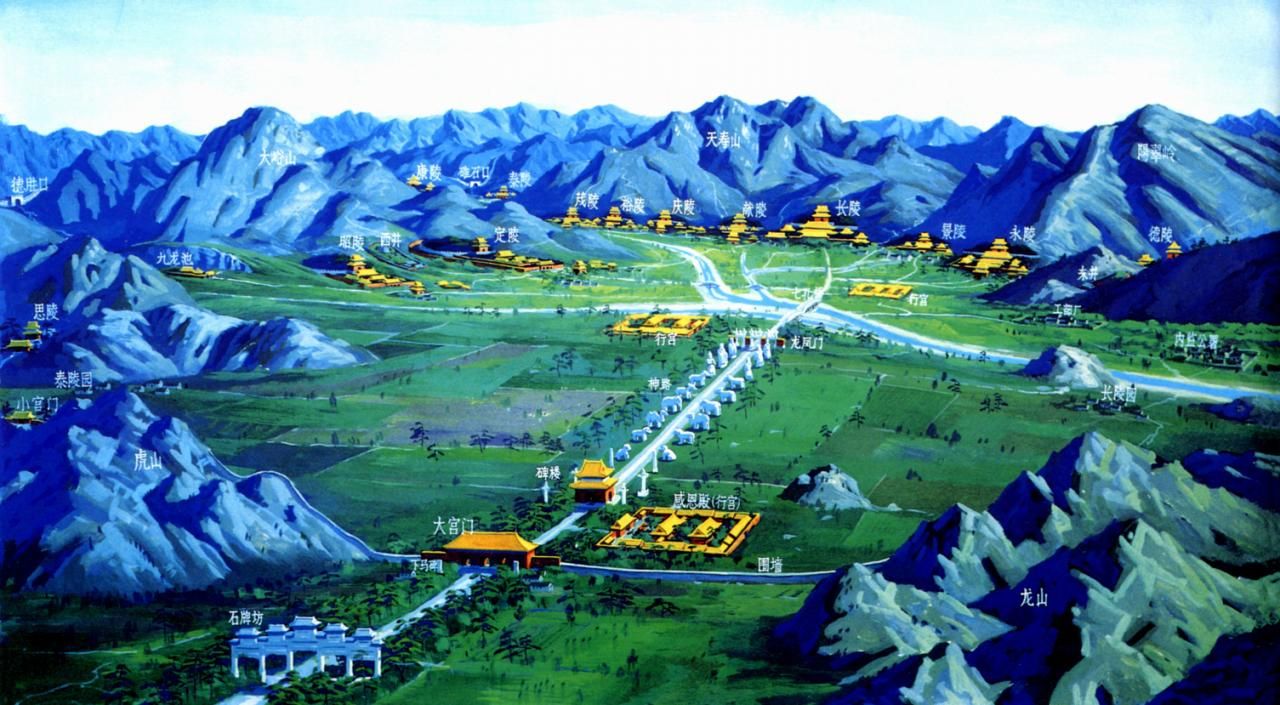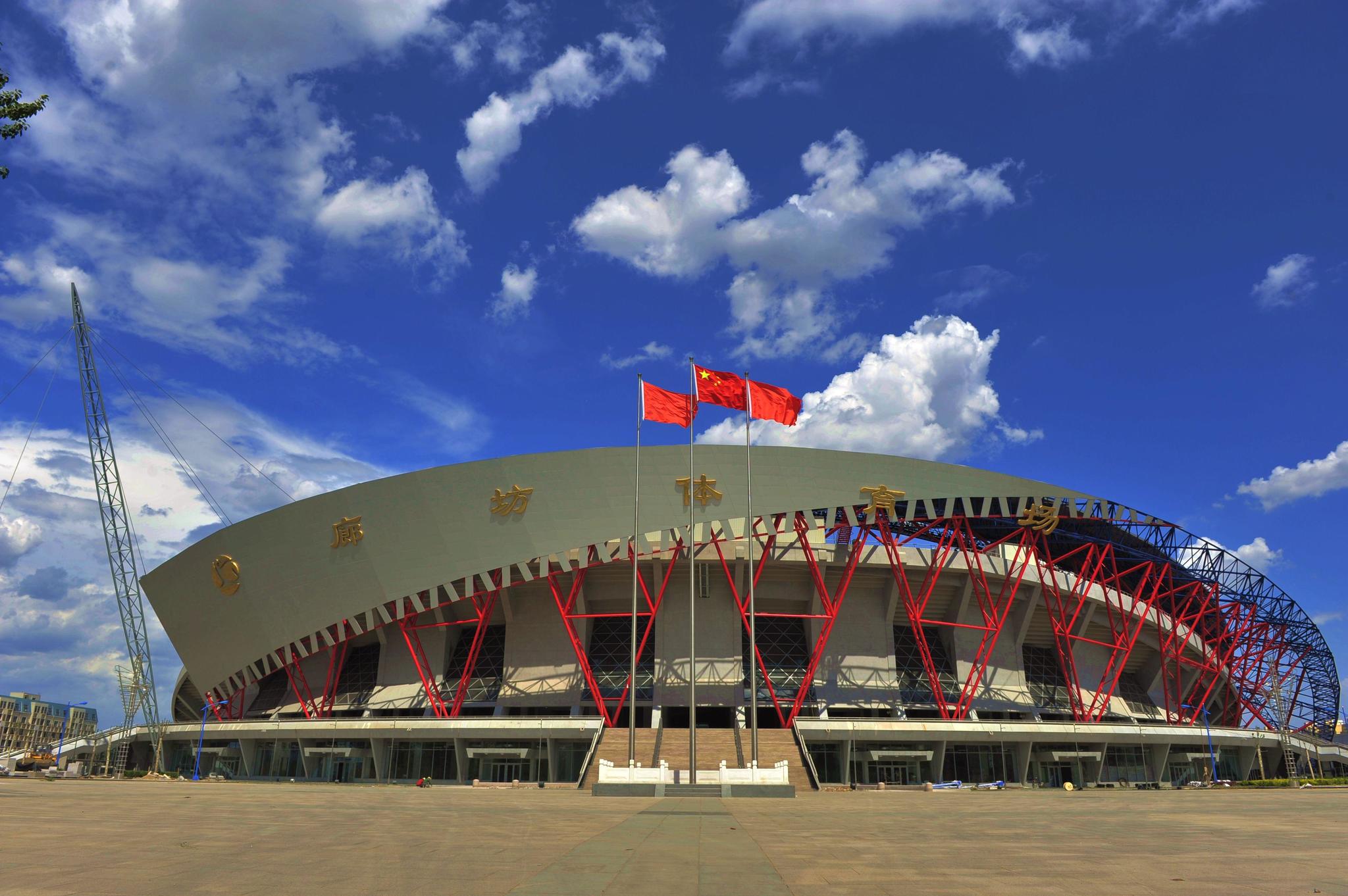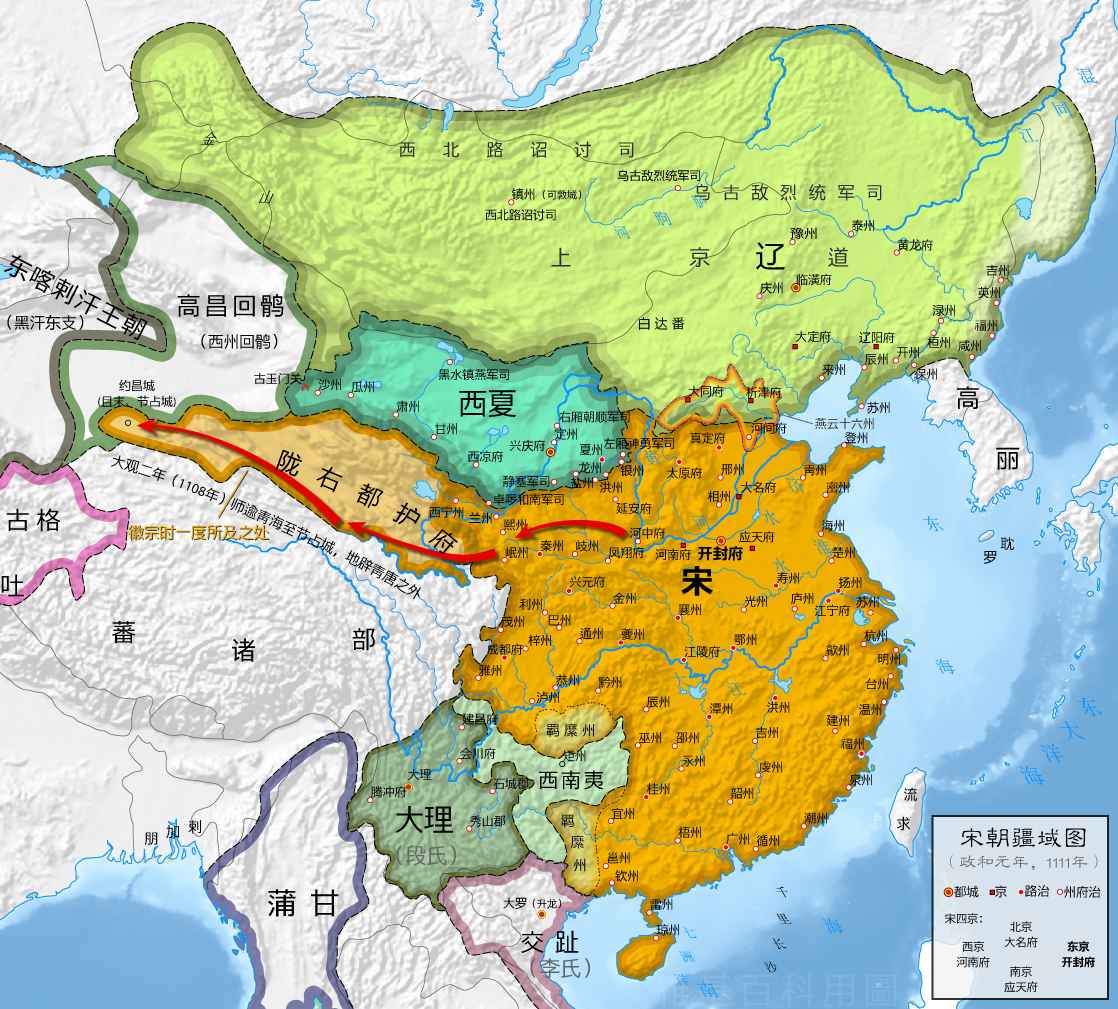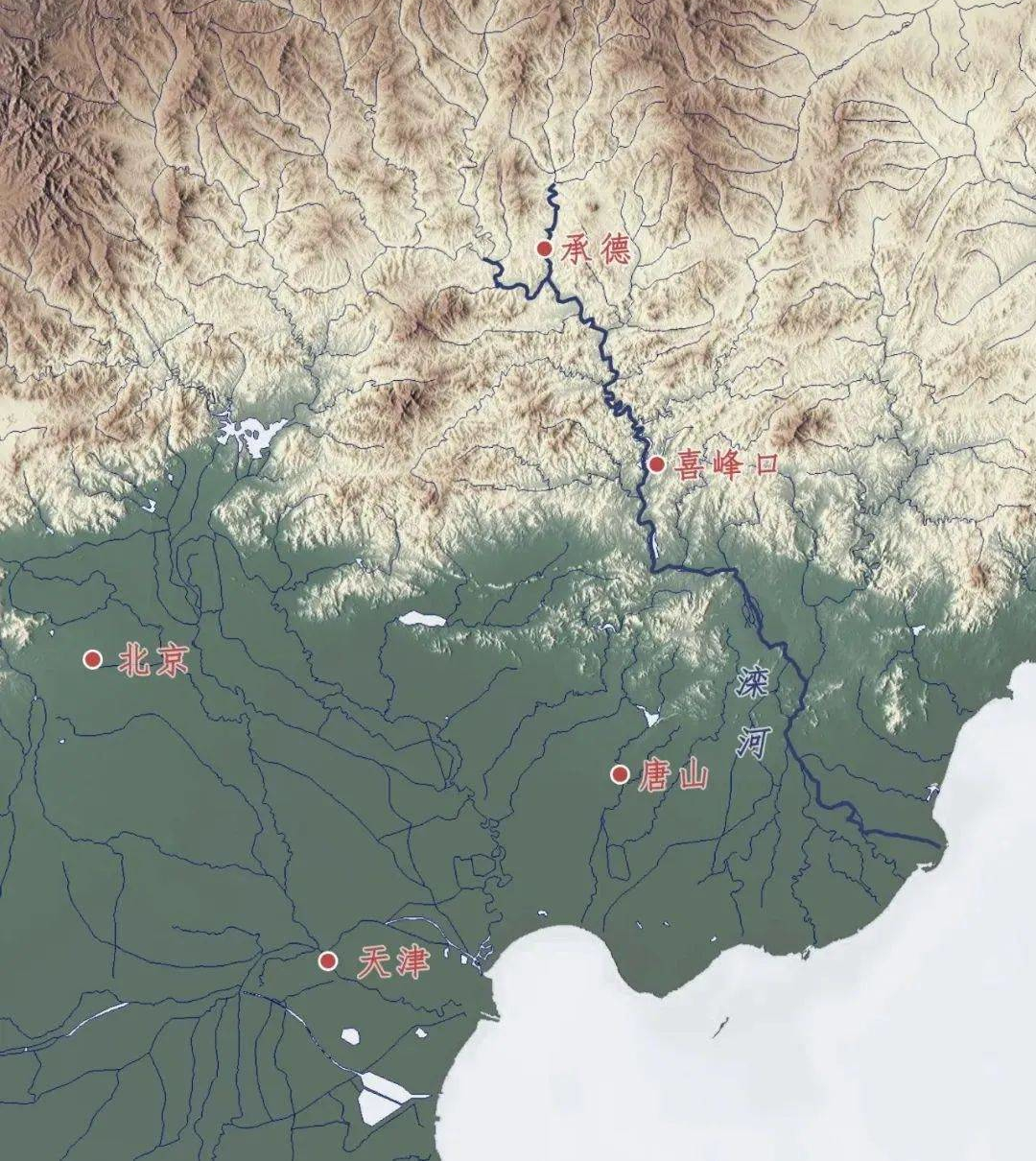
Deutsch-Chinesische Enzyklopädie, 德汉百科
 Hebei Sheng-HE
Hebei Sheng-HE

 Architecture
Architecture
 Beijing Shi-BJ
Beijing Shi-BJ
 China
China
 Hebei Sheng-HE
Hebei Sheng-HE
 Imperial tombs of the Ming and Qing dynasties
Imperial tombs of the Ming and Qing dynasties

 World Heritage
World Heritage

Die Kaisergräber der Ming- (1368-1644) und Qing-Dynastie (1644-1911) sind durch Einfluss des Menschen veränderte Naturstätten. Sorgfältig ausgewählt auf Basis der Geomantie (Fengshui) handelt es sich bei diesen um Bauten mit traditionellem Architekturdesign und Dekor. Verkörpert wird die bereits über fünf Jahrhunderte existierende Weltanschauung und das Machtkonzept des feudalen China.
Das Xian-Grab aus der Ming-Dynastie ist die Grabstätte von Fürst Xingxian und dessen Ehefrau, Eltern des Kaisers Jiaqing (Regierungszeit: 1522-1566). Die beiden wurden im heutigen Kreis Zhongxiang (Provinz Hubei) auf dem Berg Songlin gemeinsam bestattet. Das Grab mit einer Fläche von 136,47 Hektar ist durch hohe Mauern umgeben. Das Xian-Grab, dessen Bau 1519 begann und 1540 abgeschlossen wurde, ähnelt den Ming-Gräbern in der Nähe Beijings, ist jedoch flächenmäßig größer. Es gilt als das einzige Ming-Grab, das jemals in Südchina entdeckt wurde und wird oft als das 15. Ming-Grab bezeichnet. 1985 wurde das Grab unter staatlichen Schutz gestellt.
(Quelle:http://german.beijingreview.com.cn/)
Die Kaiserlichen Grabstätten der Ming- und der Qing-Dynastien (明清皇家陵寢 / 明清皇家陵寝, Míng qīng huángjiā língqǐn) sind mehrere Grabanlagen der Kaiser Chinas und ihrer Ehefrauen, welche im 15. bis 18. Jahrhundert in der Zeit der Ming-Dynastie (1368–1644) bzw. Qing-Dynastie (1644–1911) entstanden. Die Grabstätten sind über mehrere Regionen Chinas verteilt. Die UNESCO beschreibt die Bedeutung der Gräber mit fünf Kriterien: die Gräber seien ein meisterhaftes Beispiel der Integration von Architektur und natürlicher Umgebung nach den Grundsätzen des Fengshui. Sie repräsentierten die Weiterentwicklung früherer Kunstformen in der Ming- und Qing-Zeit und seien hervorragende Zeugnisse einer kulturellen und architektonischen Tradition, welche über 500 Jahre diese Weltregion geprägt habe. Die Verbindung zwischen Architektur und Natur forme eine einmalige Kulturlandschaft; die Gräber illustrierten die Weltsicht, den Glauben und die geomantischen Prinzipien des feudalen Chinas.[2]
明・清王朝の皇帝墓群(みん・しんおうちょうのこうていぼぐん)は、中国の古代王朝である明と清ならびに清の前身後金の25人の皇帝の陵墓を含む、ユネスコの世界遺産(文化遺産)に登録された物件の総称。2000年に最初の3件が登録されたのち、2003年と2004年に数件ずつの追加登録がなされている。
Imperial Tombs of the Ming and Qing Dynasties (simplified Chinese: 明清皇家陵寝; traditional Chinese: 明清皇家陵寢; pinyin: Míng Qīng Huángjiā Língqǐn) is the designation under which the UNESCO has included several tombs and burial complexes into the list of World Heritage Sites (WHS). These tombs date from the Ming and Qing dynasties of China.
Tombs were included in the list in 2000, 2003 and 2004. Three Imperial tombs in Liaoning Province, all built in the 17th century, were added in 2004: the Yongling tomb, the Fuling tomb and the Zhaoling tomb were constructed for the founding emperors of the Qing dynasty and their ancestors. These tombs feature rich decoration of stone statues and carvings and tiles with dragon motifs, illustrating the development of the funerary architecture of the Qing dynasty. The three tomb complexes, and their numerous edifices, combine traditions inherited from previous dynasties and new features of Manchu culture.
« Tombes impériales des dynasties Ming et Qing » est la désignation sous laquelle l'UNESCO a mis plusieurs complexes de tombes impériales sur la liste du patrimoine mondial en 2000, 2003, et 2004. La dynastie Ming a régné sur la Chine de 1368 à 1644. Sur les seize empereurs de la dynastie, treize sont enterrés dans une nécropole à cinquante kilomètres au nord-ouest de Pékin et à dix kilomètres au nord de Changping. L'initiateur du projet fut le troisième empereur Ming, Yongle, qui à partir de 1407 recherchait un site près de Pékin, sa nouvelle capitale. La dynastie Qing a régné sur la Chine de 1644 et 1912. Il existe deux nécropoles situées à l'est de Pékin. Dans chacune d'elles se trouvent les sépultures de cinq empereurs Qing.
Tombe imperiali delle dinastie Ming e Qing sono il nome in cui vengono raggruppate un insieme di 14 sepolture risalenti alle dinastie Ming e Qing, inserite nell'elenco dei Patrimoni dell'umanità dell'UNESCO.
Tumbas imperiales de las dinastías Ming y Qing es el nombre bajo el cual la Unesco inscribió varios conjuntos de tumbas imperiales en la lista del Patrimonio de la Humanidad en 2000, 2003, y 2004
Гробницы императоров династии Мин и Цин — памятник Всемирного наследия ЮНЕСКО, состоящий из нескольких мавзолейных комплексов в разных районах Китая, где были похоронены императоры династий Мин и Цин, в совокупности правивших Китаем более 500 лет (1368—1911 гг).



Lángfāng (chinesisch 廊坊市, Pinyin Lángfāng Shì) ist eine bezirksfreie Stadt in der chinesischen Provinz Hebei. Das Verwaltungsgebiet von Langfang hat eine Fläche von 6.429 km² und ca. 4,62 Millionen Einwohner (Ende 2016). In dem eigentlichen städtischen Siedlungsgebiet von Langfang leben 530.840 Menschen (Zensus 2010). Es wird Hochchinesisch gesprochen.
廊坊市是中华人民共和国河北省下辖的地级市,位于河北省中部,北京、天津两大直辖市之间,环渤海经济区腹地。距离北京市区和天津市区40公里和60公里,距离北京首都国际机场和天津港70公里和100公里,城市定位是京津冀城镇群中重要区域中心城市,2014年3月26日出台《河北省委、省政府关于推进新型城镇化的意见》将落实保定和廊坊首都功能疏解及首都核心区生态建设的服务作用,以发展高新技术产业和现代服务业为主的生态宜居名城。
2017年,廊坊市生产总值完成2880.6亿元,同比增长6.8%。其中,第一产业实现增加值186.5亿元,同比下降1.9%;第二产业实现增加值1262.4亿元,同比增长3.1%;第三产业增加值1431.8亿元,同比增长11.5%;城镇居民人均可支配收入37474元,同比增长8.2%;农村居民人均可支配收入15487元,同比增长8.4%。
廊坊市(ろうぼうし / ランファンシー、拼音: )は、中華人民共和国河北省に位置する地級市。常住人口約474.1万人(2017年)。中国直轄市の北京市および天津市のほぼ中間に位置し、河北省の地級市である滄州市および保定市と接する。北京市と天津市に囲まれた部分(三河市、香河県、大廠回族自治県)が飛び地となっている。
世界最大のデータセンターが設置された都市。 データセンター 総面積 58万5千平方メートル
Langfang (Chinese: 廊坊; pinyin: Lángfáng), is a prefecture-level city of Hebei Province, which was known as Tianjin Prefecture until 1973. It was renamed Langfang Prefecture after Tianjin became a municipality and finally upgraded into a prefecture-level city in 1988. Langfang is located approximately midway between Beijing and Tianjin. The name Langfang means "gallery square". At the 2010 census, the population of Langfang was 4,358,839, of whom 868,066 lived in the built-up (or metro) area made of Guangyang and Anci districts;[1] its total area is around 6,417.28 km2 (2,477.73 sq mi). Langfang borders Baoding to the southwest, Cangzhou to the south (both prefecture-level cities of Hebei), Beijing to the north and Tianjin to the east. Sanhe City and Dachang Hui County are now conurbated with Beijing, so that they form part of the same built-up area. Langfang is the smallest prefecture-level city of Hebei Province by land area.
Langfang (廊坊 ; pinyin : Lángfáng) (ou Anci) est une ville du centre de la province du Hebei en Chine. Elle compte 277 600 habitants. Dans les environs on cultive le grain, les légumes, les fruits, le coton et les plantes oléagineuses.
Langfang (cinese: 廊坊; pinyin: Lángfáng) è una città-prefettura della Cina nella provincia dello Hebei.
Langfang (en chino: 廊坊市, pinyin: Lángfángshì]) es una ciudad-prefectura de la zona centro-oriental de la provincia de Hebei, República Popular de China. Ubicada aproximadamente a mitad de camino entre Pekín y Tianjin, su área es de 6429 km² —lo que la sitúa como la división más pequeña de la provincia— y su población, 3 850 000 personas. Limita al norte con Pekín, al este con Tianjin, al sur con Cangzhou y al oeste con Báoding. Es considerada como un nexo entre Pekín y Tianjin.
Ланфа́н (кит. упр. 廊坊, пиньинь: Lángfāng) — городской округ в провинции Хэбэй КНР. В состав округа также входит эксклав Саньхэ (состоящий из городского уезда Саньхэ, уезда Сянхэ и Дачан-хуэйского автономного уезда), полностью заключённый между территориями городов центрального подчинения Пекин и Тяньцзинь.


 Chinese Academy of Science
Chinese Academy of Science
 Hebei Sheng-HE
Hebei Sheng-HE



 Aerospace
Aerospace
 National Astronomical Observatories,Chinese Academy of Sciences,NAOC
National Astronomical Observatories,Chinese Academy of Sciences,NAOC

 Beijing Shi-BJ
Beijing Shi-BJ
 Gansu Sheng-GS
Gansu Sheng-GS

 History
History
 L 1000 - 1500 AD
L 1000 - 1500 AD
 Hebei Sheng-HE
Hebei Sheng-HE
 Heilongjiang Sheng-HL
Heilongjiang Sheng-HL
 Jilin Sheng-JL
Jilin Sheng-JL
 Liaoning Sheng-LN
Liaoning Sheng-LN
 Nei Mongol Zizhiqu-NM
Nei Mongol Zizhiqu-NM
 Ningxia Huizu Zizhiqu-NX
Ningxia Huizu Zizhiqu-NX
 Qinghai Sheng-QH
Qinghai Sheng-QH
 Shaanxi Sheng-SN
Shaanxi Sheng-SN
 Shanxi Sheng-SX
Shanxi Sheng-SX

辽朝(907年-1125年),国号大辽,又称大契丹国(契丹国,契丹大字:![]() )[注 1],是中国历史上由契丹人建立的一个朝代,国祚210年[2]。
)[注 1],是中国历史上由契丹人建立的一个朝代,国祚210年[2]。
契丹族首领耶律阿保机吞并了契丹各个部落后,于916年称帝建国“契丹”。918年定都临潢府(今内蒙古巴林左旗南)。契丹屡次南下中原,946年阿保机之子耶律德光攻灭后晋后确定国号为“大辽”[注 2],983年改为“契丹”,1066年改为“大辽”[3],直到1125年3月26日为金朝所灭为止。除了辽朝之外,契丹族尚建立相关国家。1122年,天祚帝北逃夹山,耶律淳于辽南京被立为帝,史称北辽[3]。辽朝灭亡后,耶律大石西迁到中亚楚河流域,1132年建立西辽。1211年西辽被屈出律篡位,1218年被蒙古帝国所灭。
史学界对“契丹”含义最广为接受的说法是镔铁或刀剑之意。后来改国名为“辽”也是“铁”的意思,同时“辽”也是契丹人发祥地辽水的名字,以示不忘本之意。又因与南方的中原政权长期对峙,而称“北朝”,而称中原王朝为“南朝”[4]。辽朝926年灭渤海国,938年据燕云十六州,后灭后晋,自居为继承后晋的中原正统,即使之后退回北方。依据五行德运说的五行相生规律,后晋的“木”德之后为“水”德,因此辽朝以水为德运,并相应以黑色为正色。[5]
辽朝全盛时期疆域东到日本海,西至阿尔泰山,北到额尔古纳河、大兴安岭一带,南到河北省南部的白沟河。契丹族本是游牧民族,辽朝皇帝使农牧业共同发展繁荣,各得其所,建立独特的、比较完整的管理体制。辽朝将重心放在民族发祥地,为了保持民族性将游牧民族(契丹人)与农业民族(汉人)分开统治,主张因俗而治,开创出两院制的政治体制。并且创造契丹文字,保存自己的文化。此外,吸收渤海国、五代、北宋、西夏及西域各国的文化,成效地促进辽朝政治、经济和文化各个方面发展。辽朝的军事力量与影响力涵盖西域地区,因此在唐朝灭亡后中亚、西亚与东欧等地区常将辽朝(契丹,英语作Cathay)当做中国,[6]。
Die Liao-Dynastie (chinesisch 遼朝 / 辽朝, Pinyin Liáocháo) war eine Dynastie im Norden Chinas von 916 bis 1125. Das Herrscherhaus und ein Teil der Untertanen waren Angehörige des (proto-)mongolischen Volks der Kitan. Der Dynastie-Gründer war Abaoji († 926).
遼(りょう、簡体字:辽、拼音:Liáo)は、遼朝(りょうちょう)ともいい、内モンゴルを中心に中国の北辺を支配した契丹人(キタイ人)耶律氏(ヤリュート氏)の征服王朝。916年から1125年まで続いた。中原に迫る大規模な版図(現在の北京を含む)を持ち、かつ長期間続いた最初の異民族王朝であり、いわゆる征服王朝(金、元、清が続く)の最初とされる。ただし、後の3つの王朝と異なって中原を支配下にはおいていない。
The Liao dynasty (/ljaʊ/;[5] Khitan: Mos Jælud; traditional Chinese: 遼朝; simplified Chinese: 辽朝; pinyin: Liáo cháo),[6] also known as the Liao Empire, officially the Great Liao (大遼; 大辽; Dà Liáo), or the Khitan (Qidan) State (Khitan: Mos diau-d kitai huldʒi gur),[7] was an empire in East Asia that ruled from 907 to 1125 over present-day Northern and Northeast China, Mongolia and portions of the Russian Far East and North Korea.[8] The empire was founded by Yelü Abaoji, Khagan of the Khitans around the time of the collapse of Tang China and was the first state to control all of Manchuria.[9]
Almost immediately after its founding, the Khitan Empire began a process of territorial expansion, with Abaoji leading a successful conquest of Balhae. Later emperors would gain the Sixteen Prefectures by fueling a proxy war that led to the collapse of the Later Tang (923–936) and would establish tributary relationships with Goryeo after losing in Goryeo–Khitan Wars (1018) against Goryeo.[10] In 1004, Liao Dynasty launched an imperial expedition against the Northern Song. After heavy fighting and large casualties between two countries, the two sides worked out the Chanyuan Treaty. Through the treaty Liao forced the Northern Song to recognize them as peers.
Tension between traditional Khitan social and political practices and Chinese influence and customs was a defining feature of the dynasty. This tension led to a series of succession crises; Liao emperors favored the Chinese concept of primogeniture, while much of the rest of the Khitan elite supported the traditional method of succession by the strongest candidate. So different were Khitan and Chinese practices that Abaoji set up two parallel governments. The Northern Administration governed Khitan areas following traditional Khitan practices, while the Southern Administration governed areas with large non-Khitan populations, adopting traditional Chinese governmental practices.
Differences between Chinese and Khitan society included gender roles and marital practices: the Khitans took a more egalitarian view towards gender, in sharp contrast to Chinese cultural practices that segregated men's and women's roles. Khitan women were taught to hunt, managed family property, and held military posts. Many marriages were not arranged, women were not required to be virgins at their first marriage, and women had the right to divorce and remarry.
The Liao dynasty was destroyed by the Jurchen-led Jin dynasty in 1125 with the capture of Emperor Tianzuo of Liao. However, the remnant Khitan, led by Yelü Dashi, established the Qara Khitai (Western Liao dynasty), which ruled over parts of Central Asia for almost a century before being conquered by the Mongols. Although cultural achievements associated with the Liao dynasty are considerable, and a number of various statuary and other artifacts exist in museums and other collections, major questions remain over the exact nature and extent of the influence of the Liao Khitan culture upon subsequent developments, such as the musical and theatrical arts.
La dynastie Liao (chinois simplifié : 辽朝 ; chinois traditionnel : 遼朝 ; pinyin : ; Khitan : Mos Jælud)1, également connue sous le nom d'Empire Khitan (chinois simplifié : 契丹国 ; chinois traditionnel : 契丹國 ; pinyin : ; Khitan : Mos diau-d kitai huldʒi gur)2, est un empire d'Asie orientale qui a régné sur la Mongolie, une partie de la Russie orientale et du nord de la Chine continentale entre 907 et 1125. Elle a été fondée par le Khagan Khitan Yelü Abaoji à la suite de la chute de la dynastie chinoise Tang.
Bien que couvrant essentiellement les steppes mongoles et quelques provinces du Nord de la Chine actuelle, la majorité de la population sous le contrôle de la dynastie était d'origine Chinoise Han. Le gouvernement Khitan a donc instauré un système administratif inédit visant à prendre en compte les spécificités de chaque partie du territoire, afin de mieux contrôler les populations locales. Cette période fut également une étape importante pour les Khitans, qui formalisent leur langue écrite à cette époque et commencent à intégrer de plus en plus les coutumes traditionnelles des Chinois Han.
L'empire a été détruit par les Jürchens de la dynastie Jin en 1125. Toutefois, certains survivants du peuple Khitan, menés par Yelü Dashi, ont établi la dynastie des Liao occidentaux. Connue également sous le nom de Khanate Kara-Khitans, cette dynastie a régné sur des parties de l'Asie centrale pendant près d'un siècle, avant d'être conquise à son tour par l'armée mongole de Genghis Khan.
La dinastia Liao (cinese tradizionale: 遼朝; cinese semplificato: 辽朝; pinyin: Liáo Cháo), 907-1125, conosciuta anche come impero Kitai (契丹國 / 契丹国 / Qìdān Guó), fu una dinastia che regnò sulle regioni della Manciuria, della Mongolia e su parte della Cina settentrionale. Fu fondata dalla tribù Yelü (耶律 Yēlǜ) del popolo Kitai nell'ultimo periodo della dinastia Tang, anche se il primo sovrano, Ābǎojī (阿保機 / 阿保机), proclamò il primo periodo di regno solo nel 916.
Nel 947 (o secondo altre fonti nel 938) l'imperatore Yelü Ruǎn adottò ufficialmente il nome "Liáo" (formalmente "Grande Liáo"). Abbandonato nel 983, il nome fu poi ripreso nel 1066.
Il regno dei Liao fu distrutto dagli Jurchi della dinastia Jīn nel 1125. I superstiti, guidati da Yelü Dashi, fondarono la dinastia Liao occidentale 1125-1220 o Kara Khitay, che sopravvisse fino all'arrivo dell'esercito mongolo di Gengis Khan.
La dinastía Liao (chino tradicional: 遼朝, chino simplificado: 辽朝, pinyin: Liáo Cháo, Wade-Giles: Liao2-Ch'ao2, kitán: Mos Jælut),12 907-1125, también conocida como Imperio kitán (契丹國 pinyin: Qìdān Guó, kitán: Mos diau-d kitai huldʒi gur)3 fue una dinastía china, de origen extranjero, que gobernó gran parte del nordeste del territorio chino actual.
Los kitán, uno de los grupos étnicos tunguses, de origen altaico, que habitaban hace siglos en la actual Manchuria, fundaron en el año 907 un estado que recibió inicialmente el nombre de Estado Kitán. Más adelante, tras conquistar el norte de China, el estado asumió formas de gobierno de estilo chino tomando el nombre dinástico de Liao, por el río del mismo nombre (en la actual provincia china de Liaoning) de su tierra ancestral. El imperio de los Liao convivió con la dinastía Song, al sur, y con el Imperio Tangut (o Xia Occidental), que gobernaba parte del noroeste chino.
El imperio de los kitán cayó definitivamente en el año 1125, derrotado por otro pueblo altaico, los yurchen, que conquistaron el territorio de los Liao, y fundaron su propia dinastía, la Jin.
Del nombre "kitán" deriva el nombre "Catay" con el que se conoció a China en Europa durante la Edad Media. El nombre actual de China en ruso (Kitái), mongol (Qitad) y uigur (Hitay) tiene también este mismo origen.
Ляо (монг. Кидан улс, кит. трад. 遼朝, упр. 辽朝, пиньинь: Liao chao, палл.: Ляо Чао) — государство кидань-монголов, которое занимало просторы Северо-Восточного Китая с момента основания киданьской государственности племенным вождём Абаоцзи (Амбагай) в 907 году до мятежа чжурчжэней в 1125 году. Столицы — Шанцзин (верховная, ныне Хуэйнинфу), Ляоян (восточная), Датун (западная), Наньцзин (южная, в районе современного Пекина).




滦河,古称濡水、渜水,意通软水、弱水,唐代因谐音改为现名[原创研究?],是华北地区第二大单独入海的河流,发源于中华人民共和国河北省北部,承德市境内丰宁满族自治县西北的巴彦古尔图山北麓,向北流入内蒙古自治区,此段蒙古语称为“上都音高勒”(上都的河曲),汉语意译上都河。后向东南急转进入河北省东北部,一直向东南流入渤海,全长885公里,总流域面积达4.46万平方千米。基本都在河北省境内。滦河主要支流有武烈河、青龙河等,它穿越长城的地方形成长城的一座关口—喜峰口,流经较大城市只有承德。
滦河在内蒙古高原的上游水流缓慢,河床宽浅;中游进入燕山山脉,坡陡流急,下游进入冀东平原重又变缓,河道中淤积很多,承德以下可行小船。清朝时,皇帝曾从承德乘大船从其支流武烈河进入干流再转入支流瀑河向辽宁方向进发。但20世纪后半叶以后,由于沿岸植被破坏严重,水流减少,已经不能行大船。
滦河的中上游只经过承德一个城市,承德的工业不发达。流域内基本是非灌溉型的山区农业,因此滦河水量还比较充沛,水质比较清洁。迁西县城以上有大黑汀水库,瀑河和干流交汇处有潘家口水库。为了缓解海河下游严重缺水的状况,1983年由这两座水库引水,建成引滦入津工程,为天津和唐山调水,现在经蓟县于桥水库、北运河向天津调运的滦河水已经成为天津的主要水源。
滦河沿岸风景秀丽,郦道元在《水经注》中就曾经提到过濡水(滦河的古名)支流武烈水畔的“磬锤峰”。中上游原热河省的区域,在清朝时属于皇家禁区,两岸山上都是高大的松树,民国以后移民增多,植被破坏严重,再加上军阀和日本侵略军的盗伐,现在除了避暑山庄内已经很少能见到大树了,但次生灌木仍然能组成青山绿水的风景。下游两岸是优质稻米的主要产区。
Der Fluss Luan He bzw. Luan-Fluss (灤河 / 滦河, Luán Hé) ist ein Fluss im Nordosten der chinesischen Provinz Hebei.
Er ist 833 km lang.[1] Von seiner Quelle in der Provinz Hebei aus fließt er zunächst nordwärts in die Innere Mongolei und dann südöstlich zurück nach Hebei. Er mündet zwischen den Kreisen Laoting und Changli in den Golf von Bohai (Bo Hai). Zwischen den Städten Chengde und Qianxi liegen die Stauseen von Panjiakou (潘家口水库, Panjiakou shuǐkù) und Daheiting (大黑汀水库, Dàheiting shuǐkù).
 Religion
Religion
 International cities
International cities
 Sport
Sport
 Astronomy
Astronomy
 Eat and Drink
Eat and Drink
 Geography
Geography